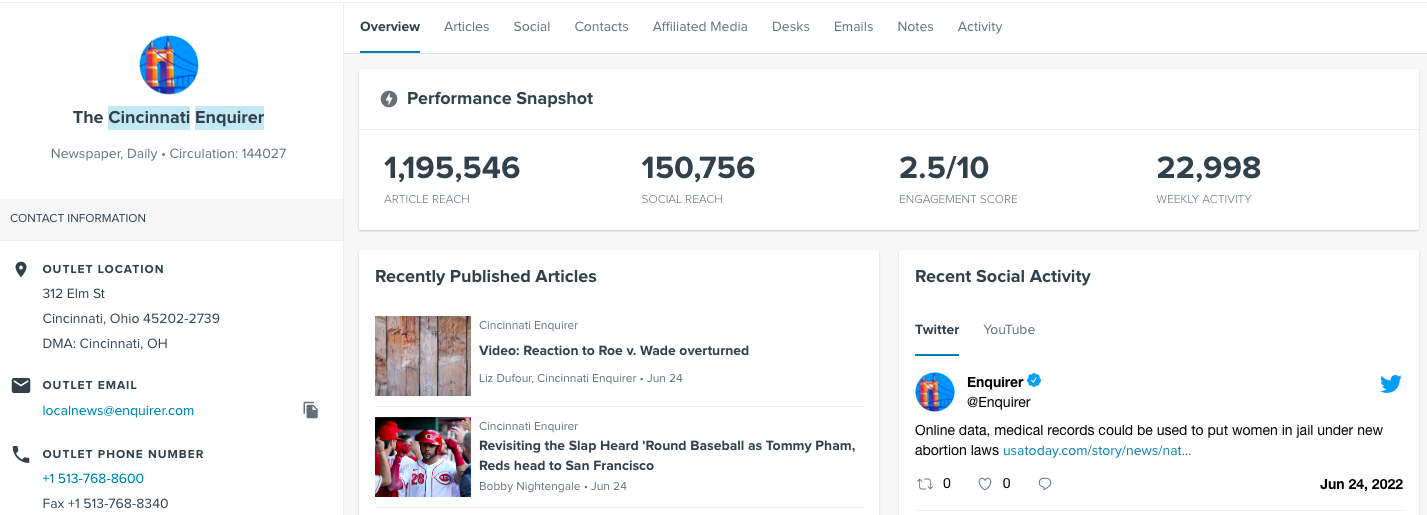Now that you are utilizing a few of the free and easy ways to track media coverage we previously identified, it’s time to begin reporting that coverage to your client. Reporting media coverage is essential to the PR process because it shows your client who is talking about their business or brand, and also offers a clear and visual representation of the media relations work you and your team are doing.
While there isn’t a “one size fits all” option for creating a media placement report, Microsoft Excel and Google Sheets are two of the most frequently used applications. These apps help to keep information organized and can be easily accessed by your team or client whenever they want to check in on coverage.
Once you’ve decided on which application to use, it’s time to get to work actually creating your placement report! This quick guide can help you determine what should be included in the placement report, along with the best ways to present that information:
1. Always Include the Essentials
When adding media coverage to a placement report, there is basic information that should be included no matter what type of placement it is (i.e. television, radio, print, digital, etc.). This information includes:
- Date
- Publication
- Medium
- Author
- Title
- Link
Providing this basic information for every placement will give your client immediate, important info to learn who is talking about their brand and why. In addition, these essentials will also give your team a high-level overview of the types of content each reporter is covering at a specific publication/outlet. If someone writes a story on your client or brand, that prior familiarity means the reporter is probably a good fit for your pitch list.

2. Advanced Metrics That Matter
Beyond this basic information, there are many other metrics that can be included in a placement report to track your team’s earned media efforts. Your client may already request that you provide this information, but even if they don’t it’s still a great idea to keep track of it to help inform PR opportunities in the future.
Some of these “advanced” reporting metrics include:
- Estimated audience reach
- Coverage type (active/passive)
- Placement type
Tracking the estimated audience reach in your placement report allows you to quantify how many people your media placements have been seen, heard, or ready by. Finding this information can be challenging, but thankfully there are many tools like Cision and Meltwater through which PR pros can access the estimated reach of nearly any media outlet with just a few clicks.
Keeping up with coverage type is another great way to showcase the work your team is doing in securing media placements. “Passive coverage” involves any mentions and/or articles that are not the result of your team’s PR efforts, while “active coverage” is secured when your team successfully pitches a story or does anything else that leads to a placement. Denoting placements as passive or active will help to clearly outline to the client all of the stories that have been secured because of you and your team.
Whether it’s a mention on a morning show, a feature story in a trade publication, or an op-ed in the local newspaper, including the placement type of each piece of media coverage in your report will provide an easy reference to utilize when pitching future stories.

3. Keep It Consistent and Current
No matter which metrics you decide to track, one of the most important considerations in creating a placement report is consistency. While the PR world can be frenetic and it’s all too easy to hastily add a placement into the report and move on, it is vital that you keep the formatting uniform to ensure all placements in the document are clean and consistent.
For example, you and your team should settle on stylistic considerations such as how to list digital outlets (name or URL), how television coverage will be reported, and more; not only does it give the report a cleaner look, but it also avoids any confusion that may come up when different people are viewing the placement report.
Another simple — but often overlooked — component of a stellar placement report is to use the same formatting throughout the entire document. Especially when copying and pasting links, article titles, and audience reach metrics into a report, it can be easy for different fonts, font sizes, and colors to sneak into the document. Take the extra time to make sure all placement entries in your report have the same look and feel, as it will make navigating the placement report much easier in the long run.
Given the number of moving parts in a PR pro’s daily work life, keeping a placement report up-to-date can be an easy task that falls off a to-do list on an especially busy day. However, it’s vital to remember the importance a placement report holds, as it’s the best testament to all of your team’s hard work, successful story placements, and the results that are driven by them.
Want to learn more about the world of media relations? Don’t miss “2022 AP Stylebook Updates: What PR Pros Need to Know” and “Six Tips for Making the Most Out of Your PR Placement.”


